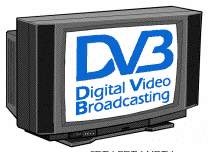

Digital Video Broadcasting (DVB) is a transmission scheme based on the MPEG-2 video compression / transmission scheme and utilising the standard MPEG-2 Transmission scheme. It is however much more than a simple replacement for existing analogue television transmission. In the first case, DVB provides superior picture quality with the opportunity to view pictures in standard format or wide screen (16:9) format, along with mono, stereo or surround sound. It also allows a range of new features and services including subtitling, multiple audio tracks, interactive content, multimedia content - where, for instance, programmes may be linked to world wide web material.
DVB is a European initiative. Equipment conforming to DVB standard is now in use on six continents and is DVB rapidly becoming the world-wide standard for digital TV.
At the time DVB was being developed in Europe, a parallel programme of standards and equipment development was also going-on in the U.S.A. by the Advanced Television Systems Committee (ATSC). ATSC is slightly different to DVB (obviously the U.S. was not too worried about this - for years they have lived with an insipid TV standard called NTSC, which has lead to slightly different TV market). Among other things ATSC adopts a different audio coding standard, and Vestigial Side Band (VSB) modulation. The U.S. has adopted a system based on ATSC, called Digital TV (DTV). During standardisation this evolved into a hot debate between the PC-based manufacturers (favouring a non-interlaced display) and the TV manufacturers (favouring an interlaced format). There is much in common between the US and European standards and inter-operation between some DVB and DTV equipment has been demonstrated.
The DVB system is based on a generic transport system which does not impose any restriction on the type of material being sent. Transmission techniques have been defined for video, audio, Electronic Programme Guides (EPG) (multi-media magazine-style), Electronic Service Guide (ESG) teletext-style programme guides which are processed and displayed using the receiver's menus), pay-per-view TV, data carousels (resembling traditional teletext). There is even provision for the transmission of Internet Protocol packets over the same system.
Using DVB, a single 38 Mbps Satellite DVB transponder (DVB-S) may be used to provide one of a variety of services:
Alternatively, any combination of services may be simultaneously carried up to the maximum transponder capacity.
The MPEG-2 system is designed to be open - allowing receivers to implement as much or as little functionality as they need. All parts of the standard allow for manufacturers to add sophistication and additional features to discriminate their products, while providing the basic functions required for interoperability.
DVB Standards and related documents are published by the European Telecommunications Standards Institute (ETSI). These include a large number of standards and technical notes to complement the MPEG-2 standards defined by the ISO.
See also :
